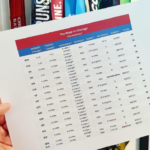Before you can get to a marathon training cycle, whether it’s 16 or 20 weeks, you need a solid base to start with. Marathons are no “Couch to 5k” kind of scenario either. It’s more like “couch to 5k to 10k to 10-miler, then get ‘comfortable’ at the 10 miles.”
I say “comfortable” in quotes because let’s be real: who really thinks that is comfortable? Comfortable is a squishy sofa AFTER the long run and ice on all the joints. The advice should really be more like “a 10-mile run is doable without feeling like you’re dying.”

Nonetheless, I needed to get back to 10 milers being the norm. Because I ran in a marathon in early March, you may think this was no sweat. However, what I haven’t shared publicly until now is that I had abdominal surgery just three days after that marathon and got benched for 4 weeks.
(Surgery is a story for another day, but all is fine, I just have a very nice little six-inch smile I didn’t have before.)
It’s common to take time off after a marathon. In fact, it’s recommended. You just put your body through a hella-tough ordeal for HOURS on end so two weeks sans running is pretty standard.
However, add in all of my hard-earned abdominal strength, which helps with the lifting knee portion of a running stride, being severed laterally and I had a monstrous hill to climb to get back to my former fitness. The kicker for me though lay in the mental hills to overcome more so than the physical and knowing I had to basically start at square one of base building despite having 2 marathons under my belt within the past four months. Womp womp.
I had come back from physical setbacks before. Heck, I had come back from mental setbacks before too. But four weeks without running really did a number on my mindset and got me itching to get back to marathon shape.
So as soon as the doctor cleared me to up my physical game from walking to running, I did just that.
Let the Base Building Begin
Here’s what April – Mid-June looked like for me:
Walk-run-walk
As much as my head wanted to take off and just run free like Forrest Gump, I knew my body wasn’t going to have it and then my head would pay the price later when I had to take more time off. So slow and steady is where I stayed for 3 miles with walk breaks every mile or so. And by slow, I mean 2-3 minutes slower than my normal easy run pace.
I rested every other day to give my body a chance to recover and for me to really tune into any signs of soreness or injury that would put me on the bench longer. When none came, I would go back out and run again for either a smidge longer than before OR reducing the number of walk breaks.
Adding in Strength Training
 After a week of “running” on the plan above, I got back into strength training, which for me means weekly trips to Orangetheory Fitness (OTF). With so many running routes to plan to get my miles in, it’s nice to just show up and do what I’m told – and see the result of course.
After a week of “running” on the plan above, I got back into strength training, which for me means weekly trips to Orangetheory Fitness (OTF). With so many running routes to plan to get my miles in, it’s nice to just show up and do what I’m told – and see the result of course.
A friend of mine from high school introduced me to OTF a little over a year ago and I fell in love. It requires zero planning on my part beyond showing up and once I am there, I give it my all. Always. Again though, I started slow with just body weight exercises rather than the heavier lifting I usually do and worked my way up in weights one week and five pounds at a time.
Sprinkle in some of their signature speed work on the treadmill and cross training on a rowing machine and each week I started to feel stronger.
How Strength Training Affects Running Performance
Between my first and second marathons, I learned just how much weight lifting can make a difference in my running.
During my first marathon training cycle, I became so focused on getting in the weekly mileage and just knowing I could cover the distance for the race that cross training and weights fell by the wayside as marathon day approached.
The positive: I did the best I could at the time and I got across the finish line.
The not-so-positive: My bottom got flat(ter) and I lost some of the definition I had in my legs (go figure!), which meant a hilly marathon course became even more challenging without my biggest muscle groups to support me.
The lesson: I can cut down on mileage if I need to due to time constraints in my week in order to fit in strength training.
I applied this lesson during my post-Marathon 1 training and sure enough, I got across the Marathon 2 finish line faster, with better form, and the “omg I need to walk a min” feeling didn’t come until 4 miles AFTER it had in the first marathon. Win for strength training!
Adding in Long Runs

Even though I wasn’t running hard or very long, I got myself back into the training cycle mentality with an early morning run each Saturday. During a training cycle these will be when I do long runs (aka double digit distances), but seeing as I was coming back from an injury, six miles became long to me.
Following a traditional marathon training plan, I increased the mileage on those “long” runs for three weeks in a row, then decreased. Paired with my mid-week training, which I kept under six miles each workout, I worked my way back up to 10 miles eight weeks post-op.
It didn’t need to be a pretty, gazelle-like 10 mile run, it just needed to get done. And it did. Then the following week I’d drop back down to 7 or 8, then go back up to 10 after that.
With numerous 7 and 8-mile runs, and three 10-milers, under my belt I felt strong physically and as strong mentally (at least as I can be at this point) to tackle this next structured training cycle.
Stick around for the Week 1 recap coming Sunday!



Comments are closed.